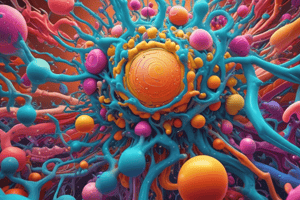Podcast
Questions and Answers
What type of transport process requires cellular energy (ATP) and moves molecules against their concentration gradient?
What type of transport process requires cellular energy (ATP) and moves molecules against their concentration gradient?
- Active transport (correct)
- Osmosis
- Passive transport
- Facilitated diffusion
Which membrane-spanning proteins use ATP hydrolysis to create a concentration gradient that drives substance transport across the membrane?
Which membrane-spanning proteins use ATP hydrolysis to create a concentration gradient that drives substance transport across the membrane?
- Pores
- Receptors
- Carriers (correct)
- Channels
What is the structure of the cell membrane, allowing the selective permeability by restricting polar substances while permitting the passage of nonpolar molecules?
What is the structure of the cell membrane, allowing the selective permeability by restricting polar substances while permitting the passage of nonpolar molecules?
- Phospholipid trilayer
- Glycoprotein network
- Phospholipid bilayer (correct)
- Single-layer phospholipid
Which type of membrane proteins are responsible for the specific transport of substances across the membrane?
Which type of membrane proteins are responsible for the specific transport of substances across the membrane?
How is the regulation of transport processes achieved for maintaining cellular homeostasis and adapting to environmental changes?
How is the regulation of transport processes achieved for maintaining cellular homeostasis and adapting to environmental changes?
Why is understanding the structure and function of cell membranes crucial in developing targeted therapies and understanding disease pathologies?
Why is understanding the structure and function of cell membranes crucial in developing targeted therapies and understanding disease pathologies?
What is the main difference between simple diffusion and facilitated diffusion?
What is the main difference between simple diffusion and facilitated diffusion?
Which type of transport relies on the movement of substances through the interstices between phospholipid molecules in the membrane?
Which type of transport relies on the movement of substances through the interstices between phospholipid molecules in the membrane?
What is the role of membrane-spanning proteins in facilitated diffusion?
What is the role of membrane-spanning proteins in facilitated diffusion?
Which protein assists in the facilitated diffusion of glucose across the cell membrane?
Which protein assists in the facilitated diffusion of glucose across the cell membrane?
In which type of transport do substances move from an area of high concentration to an area of low concentration until equilibrium is reached?
In which type of transport do substances move from an area of high concentration to an area of low concentration until equilibrium is reached?
What is the primary mechanism by which passive transport occurs?
What is the primary mechanism by which passive transport occurs?
Study Notes
Transport Membrane Structure and Function
The transport of substances across cell membranes is crucial for various cellular processes, such as nutrient uptake, waste disposal, and signaling. Membrane structure and function play a significant role in regulating these processes. In this article, we will discuss the mechanisms of passive and active transport, the role of membrane-spanning proteins, and the importance of cell membrane structure in the context of transport.
Passive Transport
Passive transport is the movement of substances across the cell membrane without the involvement of cellular energy. It can occur through two primary mechanisms: simple diffusion and facilitated diffusion.
Simple Diffusion
Simple diffusion is the process by which substances move from an area of high concentration to an area of low concentration until an equilibrium is reached. This process is driven by the random movement of molecules, and it occurs through the interstices between phospholipid molecules in the membrane.
Facilitated Diffusion
Facilitated diffusion is a passive transport mechanism that involves the assistance of specific membrane proteins, such as channels. These proteins allow the movement of certain substances, such as ions, across the membrane without the need for cellular energy. For instance, glucose transport across the cell membrane is facilitated by the insulin-regulated glucose transporter protein (GLUT-4).
Active Transport
Active transport is a process that requires cellular energy (ATP) and involves the movement of molecules against their concentration gradient. This process is essential for maintaining cellular homeostasis and for the uptake of nutrients and the excretion of waste products. Active transport is mediated by membrane-spanning proteins, such as pumps and carriers, which use ATP hydrolysis to create a concentration gradient that drives the transport of substances across the membrane.
Membrane Structure and Function
The structure of the cell membrane plays a crucial role in the processes of passive and active transport. The membrane is composed of a phospholipid bilayer, with the hydrophobic tails of the phospholipids facing each other and the hydrophilic head groups facing the aqueous environment. This bilayer structure allows for the selective permeability of the membrane, as the hydrophobic tails of the phospholipids restrict the passage of polar substances, such as ions, while allowing the passage of small, nonpolar molecules, such as oxygen and carbon dioxide.
Membrane proteins, such as channels and pumps, are responsible for the specific transport of substances across the membrane. These proteins can be integral (spanning the entire membrane) or peripheral (attached to the surface of the membrane).
Regulation of Transport
The regulation of transport processes is essential for maintaining cellular homeostasis and adapting to changing environmental conditions. This can be achieved through various mechanisms, such as the expression and activity of transporters, the modulation of ion channels, and the synthesis of specific metabolites.
In conclusion, the structure and function of cell membranes play a vital role in the processes of passive and active transport. Understanding these mechanisms is crucial for developing targeted therapies and understanding the underlying pathologies of various diseases, such as pulmonary fibrosis, which are influenced by the gut microbiome and its metabolites.
Studying That Suits You
Use AI to generate personalized quizzes and flashcards to suit your learning preferences.
Description
Explore the mechanisms of passive and active transport across cell membranes, including simple diffusion, facilitated diffusion, and active transport. Learn about the role of membrane-spanning proteins, regulation of transport processes, and the importance of membrane structure in maintaining cellular homeostasis.




